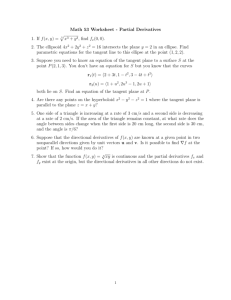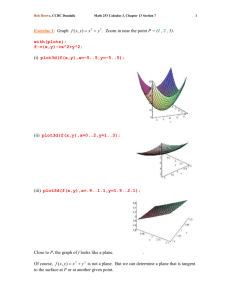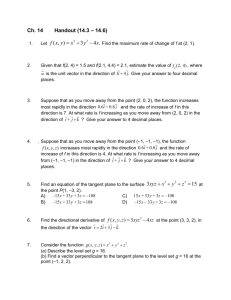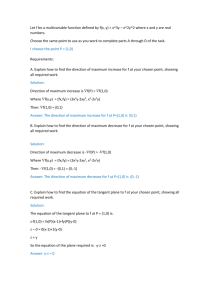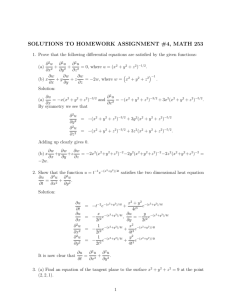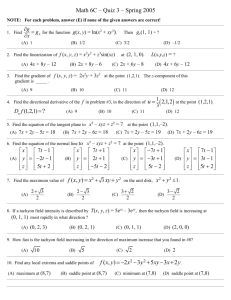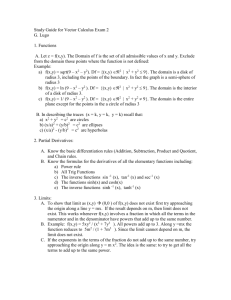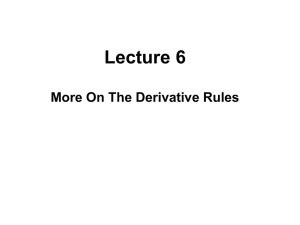12.6Tangent
advertisement
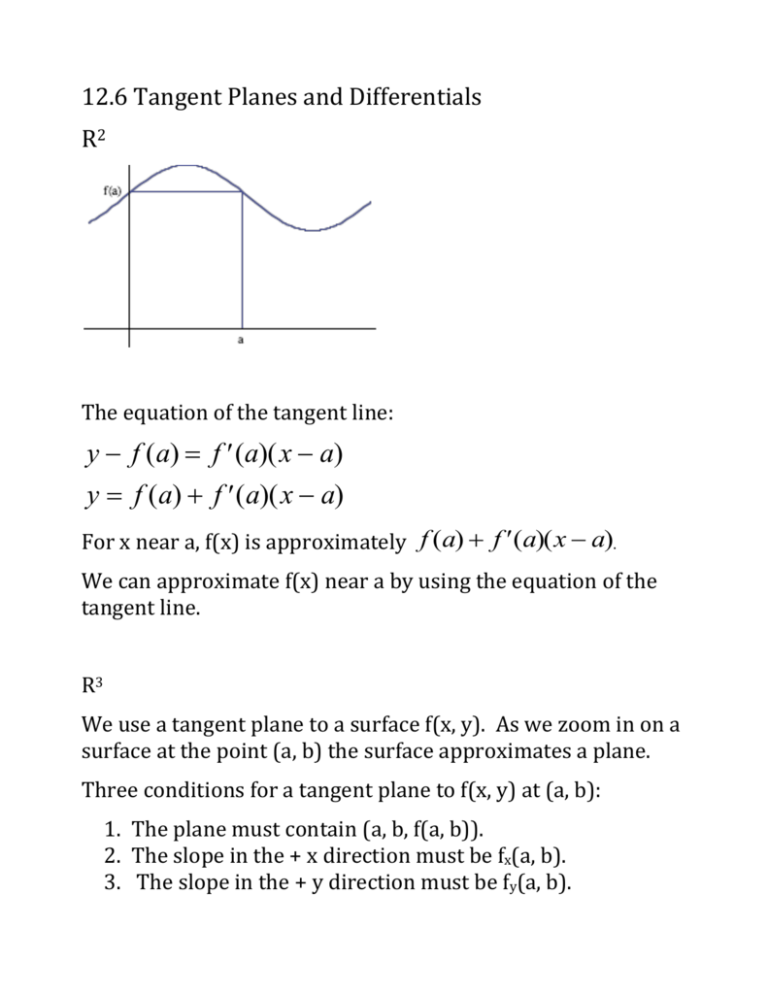
12.6 Tangent Planes and Differentials R2 The equation of the tangent line: y f (a) f (a)(x a) y f (a) f (a)(x a) For x near a, f(x) is approximately f (a) f (a)(x a). We can approximate f(x) near a by using the equation of the tangent line. R3 We use a tangent plane to a surface f(x, y). As we zoom in on a surface at the point (a, b) the surface approximates a plane. Three conditions for a tangent plane to f(x, y) at (a, b): 1. The plane must contain (a, b, f(a, b)). 2. The slope in the + x direction must be fx(a, b). 3. The slope in the + y direction must be fy(a, b). The equation of the tangent plane to z = f(x, y) at (a, b) is: z = f(a, b) + fx(a, b) (x – a) + fy(a, b) (y – b) Ex. f(x, y) = xy2 + ycos( x – 1) at P(1, 2) Ex. x + y + z2 = 7 at P(1, 2, -2) Recall from Math 1224 the equation of a plane is: r r r n1x n2 y n3z n p where n is a vector perpendicular to the plane and p is a point P(a, b, c). Another way to write this was r n x a, y b, z c 0 Suppose we have a level surface F(x, y, z) = k. (All points on r r this surface have the same function value.) Let t x, y, z be a curve on the surface through a point. Differentiate the level surface equation. By the chain rule: dF dF dx dF dy dF dz 0 dt dx dt dy dt dz dt F dx dy dz , , 0 dt dt dt dx dy dz Since dt , dt , dt is the tangent vector, F is the normal vector. Therefore the equation of the tangent plane is also: Fx(a, b)(x – a) + Fy(a, b)(y – b) + Fz(a, b)(z – c) = 0 where F(x, y, z) = k at P(a, b, c). Ex. x + y + z2 = 7 at P(1, 2, -2) Ex. f(x, y) = xy2 + ycos( x – 1) at P(1, 2) As we zoom into the surface, it becomes more like the tangent plane at that point. We refer to the linearization of the plane as the equation of the tangent plane to which it is approximating. For a function f(x, y) at a point P(a, b), the linearization is: L(x, y) = f(a, b) + fx(a, b) (x – a) + fy(a, b) (y – b) Near the point (a, b), f(x, y) is approximately L(x, y). Ex. Approximate f(x, y) = xy2 + ycos( x – 1) at P(.9, 2.1). Suppose you want the change in f when you go a small r distance ds in a specific direction u . The formula is: r df f (a,b) uds Ex. By about how much will g(x, y, z) = x + x cosz – y sinz + y change if the point P(x, y, z) moves from P0(2, -1, 0) a distance of ds = 0.2 unit toward the point P1(0, 1, 2)? Theorem: If the partial derivatives fx and fy exist near (a, b) and are continuous at (a, b), then f is differentiable at (a, b). A function is not differentiable at: 1. 2. 3. Do: 1. Find the linearization of P(4, 0). 3 2 f (x, y) 9 x y 2 at 2. Find the equation of the tangent plane at P(0, 0) for z x2 y2 . Differentials R2 R3 For z = f(x, y), the differential dz or df at point (a, b) is given by df = dz = fx(a, b)dx + fy(a, b) dy x f (x, y) Ex. 1. Around the point (3, -2) is y more sensitive to changes in x or in y? 2. At this point what is the maximum error of the formula if dx and dy have errors of ±.01? (|dx| = |dy| = .01) 3. Suppose x changes from 3 to 3.01 and y changes from -2 to -2.1. What is the approximate change in f? Do: How accurately should x and y be measured so that the error in the area of a rectangle 2 m x 1 m ≤ .01 m2? Assume dx = dy.


